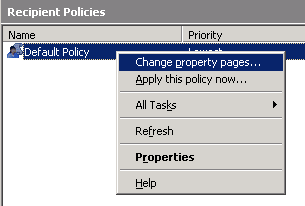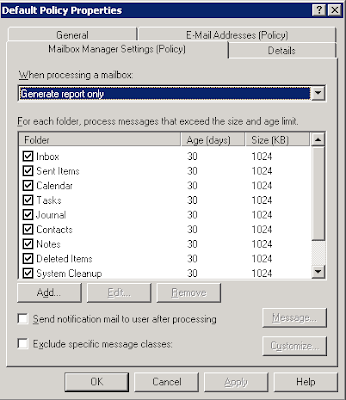The mailbox management process detects folders in a mailbox that contain messages larger than a certain size. If a message remains in a folder after a predefined time has passed (by default, 30 days), a number of predefined actions can be taken, including the following:
- Generate a report only and send the report to the mailbox owner.
- Move the message to the Deleted Items folder.
- Move the message to System Cleanup folders.
- Delete the message immediately.
Note Use caution when you use the Delete the message immediately option, because users may have to recover their messages.
If you use recipient policies, it is easy to apply or revise the rules. You do not have to reconfigure settings individually on each object. You can also change recipient policy priority levels to change the way that multiple policies are adjusted.
Note There is no default recipient policy for mailbox management (unlike the e-mail recipient policies). However, you can add the required property page to the default recipient policy if you want to create a mailbox management policy that applies to all recipients.
How do you configure Mailbox Manager Policies on the recipient policies?
Well by default these options are hidden. Right click on a recipient policy and click "Change property pages".

Click Mailbox Manager Settings.

Now the Mailbox Manager Settings will be visible under the Recipient Policy Properties.

Policies are applied according to the schedule that you set up on each server. This prevents mailbox management from running on all servers in the organization at the same time. However, you can force a manual update if you want a recipient policy to apply immediately.
Note Like e-mail recipient policies, the highest priority recipient policy that applies to an Exchange Server object is the effective policy. Lower priority policies are no longer evaluated after a match has been made.
When you use mailbox management recipient policies, you can configure a filter rule that specifies the subset of messaging-enabled objects that the recipient policy applies to. The recipient policy is then applied to objects that match the filter conditions.
This is useful when you have a subset of users who have different storage requirements. For example, there may be a technical author in your organization who regularly sends out very large attachments that must be stored. You can use a less restrictive mailbox management policy for this user.
Note You can configure mailbox storage limits to obtain a similar result. However, make sure that you note the following differences between mailbox storage limits and mailbox management recipient policies:
- Mailbox storage limits limit the total size of the mailbox.
- Mailbox management recipient policies limit messages over a certain size.
Mailbox Management must be configured to automatically run for the Mailbox Manager policies to apply. This needs to be configured on the server level in System Manager:

You can also choose to run this manually by right clicking on the Exchange 2003 server in system manager going to All Tasks.

Some parts of this document were taken from KB319188. Please refer to this article for some additional information:
http://support.microsoft.com/kb/319188



I read your posts frequently and I have to say that I like your template and of course your articles.
ReplyDeletedata recovery irvine ca
Doesn't work.. Did everything as you and others have suggested. Mailboxes get monitored, report sent. items in the "Deleted" folder remain.
ReplyDelete